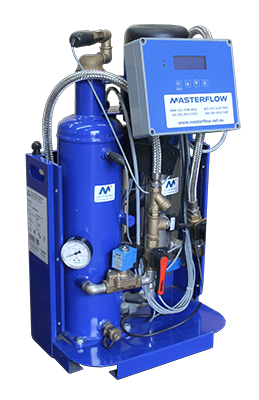The presence of air in an HVAC system contributes to premature rusting and the deterioration of metals throughout a piping network.
Removing air when it’s in a dissolved, gaseous state is akin to tackling a problem at its source.
Our vacuum degassers achieve this by:
- Taking water from the system
- Delivering it into a vessel
- Returning the degassed liquid to the system
- Lowering the pressure causes the gas to become less soluble and separates it from the liquid
Features
- Vacuum Chamber: The liquid is placed in a chamber where a vacuum is applied, creating a lower pressure environment.
- Gas Removal: As the pressure decreases, the dissolved gases, such as oxygen and nitrogen, are released from the liquid, often resulting in foaming effects that help to effectively remove the gases.
- Applications: Vacuum degassers are commonly used in industries such as water treatment, oil and gas refining, chemical production, and food processing to enhance the quality and stability of the products.
- Efficiency: The process is generally more efficient than conventional methods, allowing for deeper degassing and improved performance in downstream processes.
Overall, vacuum degassers play a crucial role in many industrial applications by ensuring that liquids are free from undesirable gases.
If your unit requires a working pressure of more than 900kPa, our team can design a bespoke system to suit a high-pressure application.
Options include:
- V4 – 4bar
- V6 – 6bar
- V9 – 9bar
The unit is suitable for use in systems filled with clean water or mixtures of water with a maximum of 40% glycol. Use in combination with other fluids may result in irreparable damage.
A unit with a refill function can control the pressure of the installation. To control the pressure, the unit inserts additional degassed fluid into the installation, if necessary. The unit can also fill the entire installation with degassed fluid.
The unit starts up a degassing process each day at a time set by the user.
The process has two phases:
- The rinsing phase (the fluid flows from the installation through the solenoid valve (S) into the vessel. The pump continuously pumps the fluid from the vessel into the installation. Here the fluid absorbs gases present in the installation.)
- The vacuum phase (the solenoid valve (S) regularly closes, starting a vacuum phase. The continuously running pump provides under pressure in the vessel. The under pressure causes the release of the gases dissolved in the fluid, which are collected at the top of the vessel. The gases are removed from the installation through the automatic air vent. The SmartSwich at the automatic air vent makes sure that the stopped as soon as the content of dissolved gases has reached the minimum level. The solenoid valve (S) opens again, at the end of the vacuum phase.)
Which criteria of a System are particularly good for degassers ?
Degassers are systems used to remove dissolved gases from liquids, often in applications like water treatment, oil refining, and chemical processing. Key criteria that are particularly good for degassers include:
- Efficiency: The system should effectively remove gases while minimizing energy consumption.
- Material Compatibility: The materials used in construction should be compatible with the fluid and gases being processed to prevent corrosion or degradation.
- Operating Pressure and Temperature: The system should operate effectively under the specific pressure and temperature ranges of the application.
- Flow Rate: It should accommodate the necessary flow rates, ensuring that the process remains efficient.
- Footprint: A compact design can be beneficial, particularly in space-constrained environments.
- Maintenance Requirements: Low maintenance needs can lead to reduced downtime and operational costs.
- Automation Capability: Systems that can be easily automated provide better control over gas removal processes.
- Scalability: The ability to scale the system according to changing operational demands is crucial for long-term use.
These criteria help ensure that degassers function effectively and efficiently in their intended applications.
Frequently asked Questions
- What is Vacuum Degasser?
A vacuum degasser is a device used to remove dissolved gases from liquids, particularly in processes where the presence of these gases can adversely affect product quality or process efficiency. It operates by creating a vacuum environment, which lowers the boiling point of the liquid and enables gases to escape more readily.
- What is the difference between an air separator and a vacuum degasser?
The Optivent Vacuum Degasser releases dissolved gasses in water, but an Optivent Air Separator releases microbubbles and free air in the system. These are different solutions.
- If I have an air separator, do I still require a vacuum degasser?
Yes. A vacuum degasser provides a solution against corrosion and extra air.
GET BETTER PERFORMANCE WITH MASTERFLOW’S RANGE OF Vacuum Degassers
Over the decades, we’ve built ourselves on our ability to provide innovative engineering solutions that work. We pride ourselves on long-term client relationships due to exceptional service. Contact us today to see how we can support you on your next project.

